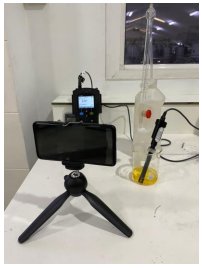
Submission to VIJ 2024-04-29
Keywords
- water pH,
- reverse osmosis,
- alkalinity,
- drinking water
Copyright (c) 2024 Djillali Benouali, Samia Benhammadi, Samira Kherici, Sofiene Kadri

This work is licensed under a Creative Commons Attribution 4.0 International License.
Abstract
One of the promising techniques to meet the needs of growing population for drinking water is the desalination of seawater and brackish water. Desalination is carried out mainly by multi-stage flash (MSF) or reverse osmosis (RO). The water obtained by desalination (RO, MSF and others processes) can be used as drinking water, after the reconstruction of its salts content (blending). However, reverse osmosis can produce, under certain pressure, flow and feed water quality, water similar in their physic-chemical properties as conductivity, Total Dissolved Salts (TDS) to bottled natural water, widely marketed. In any case, it would be interesting to be able to distinguish reverse osmosis water from sprig water. In this context, the determination of the alkalinity (TA) and the pH and subsequently the verification of the correlation between these two parameters are proposed in this work. Also, a comparison of the physic-chemical quality of drinking water supplied by MSF and RO is made. The parameters, pH, conductivity, TA, TDS and hardness (TH) were discussed. These two types of water are practically identical by physic-chemical quality since the blending is done in the same way by injecting CO2/Calcium carbonate. However, reverse osmosis water contains more sodium chloride because of the low retention rate of membranes against this ion.
References
- Országh J. (1995) "La bio-électronique et l'eau alimentaire" 1er Symposium International sur la bio-compatibilité de l'eau, des boissons et de l'alimentation. Niederbronn-les-Bains (Alsace) 23-24 mars 1995. www.astrosurf.com/luxorion/Sciences/eaux-minerales.xls
- Rummi Devi Saini, (2017) Health Risks from Long Term Consumption of Reverse Osmosis Water. International Journal of Applied Chemistry. 13, 2, 293-301. www.ripublication.com
- Payment P, Franco, Richardson L. (1991) Gastrointestinal health effects associated with the consumption of drinking water produced by use of domestic reverse osmosis filtration units. App Environ Microbiol, 57, 947-948.
- Jansen Silalahi, Siti Morin Sinaga, Nahitma Ginting, Fathur Rahman. (2019)Education on the impact of reverse osmosis (ro) drinking water toward health in village pb Selayang II Medan. Abdimas Talenta. Jurnal Pengadian Kepada Masyarakat, 4, 2 https://doi.org/10.32734/abdimastalenta.v4i2.4232
- Payment P., Franco E., Richardson L., Siemiatycki J. (1991). Gastrointestinal health effects associated with the consumption of drinking water produced by point-of-use domestic reverse-osmosis filtration units. Applied and environmental microbiology. 57.4. 945-948. https://doi.org/10.1128/aem.57.4.945-948.1991
- Munhoven G. (2013) Mathematics of the total alkalinity–pH equation – pathway to robust and universal solution algorithms: the Solve SAPHE package, Geosci., 6, 1367–1388. http://www.geosci-model-dev.net/6/1367/2013
- Bijay Kumar Mallik (2014). correlation and regression study on physico-chemical parameters of ground water nearby tlawing river at bairabi, kolasib, mizoram, india, International Journal of Geology, Earth and Environmental Sciences,. 4, 1, 220-223 http://www.cibtech.org/jgee.htm
- Nasr M., Farouk Zahran H. (2014), Using of pH as a tool to predict salinity of groundwater for irrigation purpose using artificial neural network, Egyptian Journal of Aquatic Research, 40, 111–115.